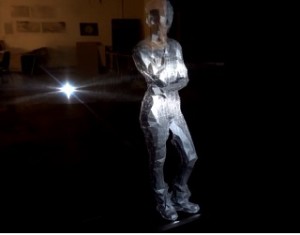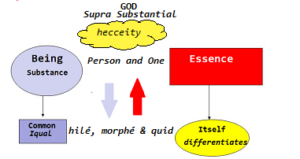
Resultados da busca ‘holograma’
The Tesseractus or Hypercube, and hologram
Why should space be limited to three independent directions ?, with this speculation Charle H. Hilton (1888) transgresses the idea of absolute time.
 After a discussion of Kant’s ideas of absolute time, he penetrates into the deeper discussion of idealism which is the separation of object and subject.
After a discussion of Kant’s ideas of absolute time, he penetrates into the deeper discussion of idealism which is the separation of object and subject.
The first postulate of this book is that the medium is no longer what separates, but what unites us to the object, builds further on a consequence: “The next step after having formed this power of contraction in a wider space is to investigate the nature, and see what phenomena are to be explained by the four-dimensional relationship, “which he will develop in his book until he gets to the hologram’s foresight:” And so with arrangements of superior space. We can not “put them in fact,” but we can say how they would look and be at the touch of various sides, “which may be seen as the foresight of a great hologram, but with the possibility of being touched.
Just as the Cube actually has 6 faces, a fourth dimension would not only be 6 cubes, but 7 cubes, thus forming the fourth dimension, it is from this that one can think of the hologram that is spatially and with the possibility of touch (haptics) it becomes a hypercube of spatial volumetric images.
Christus Hypercubus by Salvador Dali is this fourth dimension view, that placing it in a hologram and showing its reconstruction in 3D cubes constituted a stage of the current work, still not having the connection with the environment of the Multimodal Art Gallery and the possibilities of be tactile (the haptics).
Salvador Dali’s painting can be thought of as an image in the fourth dimension, or the hologram depicting in Salvador Dali’s Christus Hypercubus.
Quantum physics is connected to this idea because Heisenberg was one of the first to announce this break with the idea of absolute space, thus creating a dimension superior to three-dimensional space.
Hilton, C. H. (1888). A New Era of Thought, Londres: S. Sonnenschein & Co.
Hologram make success
Of unexpected firmness, a singer who is a three-dimensional hologram, Hatsune Miku conquered crowds for her shows in various cities of Japan.
crowds for her shows in various cities of Japan.
Hatsune fans, which is a holographic production simulating a 16-year-old girl, shake their luminous apathetic and shake during the show as if the artist were real.According to the Daily Mail report, Hatsune’s voice was created with voice samples from Japanese actress Saki Fujita. All these samples contain sounds that, when placed in series, become words and phrases.
Make holograms real, fast and accurate
We have already mentioned the development of holograms in space without the need for devices that recreate the artifacts, now it is possible to do them in an ultra-fast and very precise way. Scientists at the Lawrence Livermore American Laboratory in California have developed a technique that can create complex objects in seconds, we can say using Shannon’s sampling theorem for imaging, now being three-dimensional.
need for devices that recreate the artifacts, now it is possible to do them in an ultra-fast and very precise way. Scientists at the Lawrence Livermore American Laboratory in California have developed a technique that can create complex objects in seconds, we can say using Shannon’s sampling theorem for imaging, now being three-dimensional.
This technique creates the objects in layers simultaneously, the details were published in the journal Science Advances in December 2017, there are two really important innovations there, the possibility of creating real images in ultra-fast mode using a photosensitive resin recreating 3D printing with a powerful laser which hardens this resin making it a plastic.
This can also be done with metals using electron beam and a metal powder instead of the resin, so does not need the numerous supports required for 3D printers. LLNL engineer Maxim Shusteff, who leads the study, told New Atlas: “The fact that you can make totally 3D parts, everything in one step really overcomes a problem in additive manufacturing”, now holograms can return to material parts.
Another option would be live tissue bio-printing: “We made a good first attempt,” Shusteff said, “but we have not yet taken it to the limit of its performance, so the space is open to us and others to demonstrate what this approach is able to do. “living tissue bioprinting. “We made a good first try,” said Shusteff,
If 3D printing was already heralded as a revolution, this new technique promises to further accelerate this process
The holograms arrived
Although they are recent and there is still a lot of technology to become “augmented” realities in our daily lives, the holograms have come down the path that is the fastest to anticipate, the art world.
realities in our daily lives, the holograms have come down the path that is the fastest to anticipate, the art world.
In many recent environments headseats are needed to merge the hologram with the real world, and create what has become known as augmented reality, others use 2D projections or mirrors to trick our brains and see the figures in mid-air, but now the Leap into the future was audacious.
According to artist Joanie Lemercier, he imagined the technique thought in the films Minority Report and the saga Star Wars, to give life to the “no-attainment”, the vision that has of the augmented reality, and to make the visitors of his “installations” enjoy The content in its own perspective without depending on specific equipment, and for the time being, are geometric projections and forms produced in sensing (for example, a human body or an artistic piece), geometric shapes and dynamic movements to entertain the public.
But it uses “traditional” monitoring technologies such as image analysis and depth sensors to make shapes properly designed.
While the industry scenario continues to be sophisticated, this simpler scenario seems to be more effective as it resorts to existing technologies, and by creating virtually human forms (see one of Lemercier’s projections), it seems more effective.
The artist himself predicts that in the very near future, he thinks of using compressed gas and mists with fine particles of water to display projections in an environmentally harmless environment, and that they will be simulating volumetric impressions in immersive environments
Holograms tactile
The invention comes from the University of Bristol,  England, where through micro-speakers can touch and feel the images projected in 3D, as news in Daily Mail.
England, where through micro-speakers can touch and feel the images projected in 3D, as news in Daily Mail.
The technique is being called tactile holograms, and the effect is produced by the strong changes in the molecules that make up the air using small speakers that produce ultrasound, the virtual objects created by holograms, sensations in the hands in three dimensions.
The next necessary step now is that the technology integrates conventional holograms production technologies, giving the impression that he can play the virtual object, for example, transmitted video calls from a person, it would be possible to greet her.
The great application thought initially is in medicine, where holographic images of tumors could be played by doctors, helping the most accurate understanding of the size of the affected area, assisting the diagnosis and treatment of cancer.
Empresa inaugura uso de hologramas em shows
Imagens do falecido rapper Tupac Shakur foram vistas em um festival em abril deste ano num festival em Coachella (California, EUA), conforme o video do site The Hollywood Gossip.
Tupac é para muitos o maior rapper americano, filhos de pais ativistas dos panteras negras, e cantor de músicas de “protesto”, na noite de 7 de setembro de 1996 foi atingido por quatros tiros em um tiroteio, dentro do carro de Suge Knight (um diretor executivo da Death Row Records, que o havia retirado de uma prisão anos antes) e faleceu com apenas 25 anos de idade.
A maioria das canções de Tupac tratam sobre a vida no meio da violência e da miséria nos guetos, o racismo, os problemas da sociedade e conflitos com os outros rappers.
Segundo o Wall Street Journal, a tecnologia não é tão complicada, com imagens de um arquivo as imagens de um show em abril deste ano em Coachella (California, EUA) não eram imagens de arquivo, mas uma imagem sintética criada em computador e projetada com o auxílio da reflexão
Hecceity, supra-substance and the divine
The pre-Socratics speculated: air, earth, ether (vacuum), fire, until the end of the Middle Ages it was speculated that everything was made up of phystis, a raw material for everything, but fire is only matter in combustion and what prevailed was Democritus’ (460 – 370 BC) primary model of the atom.
end of the Middle Ages it was speculated that everything was made up of phystis, a raw material for everything, but fire is only matter in combustion and what prevailed was Democritus’ (460 – 370 BC) primary model of the atom.
Aristotle formulated it as hilé (raw material) and morphé (form) which is also something divine beyond essence and substance, in a certain sense of appearance, also arché has the idea of the origin of all things and to which they return.
The myth Morpheus, whose etymological origin is Morphé, had the ability to appear in dreams and take on various forms of people, and on the question of what things are, the idea of quidity arises (quid – thing, what thing is, core).
Throughout the Middle Ages there remained a dialogue about quidity, which divided the nominalists and realists. Boethius is at the origin of the “quarrel of the universals”, about the idea of substance and essence. This dualism was broken up (perhaps resolved) with the hecceity of Duns Scotus, but he had formulated the theory of the supra-substantial, with something divine.
In Scotus’ hecceity, in addition to the reconciliation between essence and substance, there is a theme of profound relevance not only in the philosophical dispute between nominalists and realists of medieval scholasticism, but also among moderns, such as Heidegger and Deleuze, who used this category in their work.
The theme emerged in Boethius, both in his interpretation and translation of Porphyry and in his view of Aristotle’s Categories. His book Consolations of Philosophy was written in prison, having been unjustly accused in Rome’s palace intrigues, accused of treason by Theodoric and then executed, so his “consolations” refer in particular to his state.
Boethius’ writing follows a common pattern in the Roman period, where the Roman numbers indicate the chapters (or the book, in this case it could be CP, IA or IES) and the quotations indicate prose or poetry, a striking characteristic that gives his text a unique richness.
Poetry is used to express emotions and intensify the impact of reflections, and the alternation of styles, known as prosapoetry, is used to intensify the impact of his reflections and emotions, and in this book he elaborates on the supra-substantial, beyond the essentials and substances.
The question remains, from the atomic model we went to the subatomic, we penetrated the quarks and found phenomena and forms there that were smaller and smaller and more essential, the string theory that would explain even dark matter and black holes, suggests something like vibrations.
There could be something so divine in the whole universe that, despite not being found, its appearance suggests something supra-substantial, as Boethius theorized, and in it we update the question of the gods: what are we, where did we come from and what are the things of reality ? what are things?
The universe is a hologram, we’re in a “matrix”, it’s the structured strings.
Is there a supra-substantial divine structure as Boethius imagined the existence of God?
The existence of God as the body of the universe (Christocentric), as a supra-substantial Being, in the historical figure of Jesus, who also asks non-Christians: “Who do men say that I am?” (Lk 9:18-19, Mt 16:13-14, Mk 8:27-29) and they could not doubt his existence: “And who do you say that I am?” (Lk 9:20, Mt 16:15, Mk 8:30).
Boethius, A. (2016) Consolações da Filosofia. Transl. Luís M. G. Cerqueira. Portugal, Lisbon, Calouste Gulbenkian.
The polycrisis and thinking aloud
When we think only of everyday things, they are important and even fundamental, we often fail to perceive what is deeper involved in them, the thought and culture in which we are immersed and which are rapidly pointing to a polycrisis.
The word coined by Morin was taken up again in an interview with Le Monde, where he emphasized: “The health crisis triggered a chain of crises that were linked together. This polycrisis or megacrisis extends from the existential to the political, passing through the economy, from the individual to the planetary, passing through families, regions, States. In short, a tiny virus in an overlooked village in China has unleashed the disruption of a world” (Le Monde, April 20, 2020).
In his book VI of Method: Ethics, he explains: “Our civilization separates more than it connects. We are in a deficit of reconnection and this has become a vital necessity”, so it is impossible not to think about things from above: empathy, civility, cordiality and other values that little by little were being lost and brutalizing us as a civilization.
As a complex thinker, his thinking is antidisciplinary (in the sense of rigid specialties) and transdisciplinary (in the sense of recovering the whole lost in rigid boundaries of thought that define only one aspect of life).
Operators of complex thinking (the book Introduction to Complexity is fundamental) is, as the word itself says, intricate and comprehensive, but I highlight two essential points of its method, the dialogic and hologramatic aspect.
The dialogical considers the union of opposite and contradictory terms as complementary, for example life and death, this paradox is lived in the sacred sense in this Easter week, although it is not limited to the religious, it can and should be thought of in the existential and political.
The hologramatic points out that the apparent paradox of systems are component parts of a whole (in picture the universe formation), just as each part has prefigured an aspect of the whole, the most common example is that of the kaleidoscope, but that of the human body is also interesting, each part is alive by the functioning of the whole and helps the whole to function.
We behave like fans who are fanatical and disinterested in the whole for exercising too much a material, purely earthly and human culture that makes the whole, the high and the divine inconceivable in everyday life.
welcome to polycrisis
This is the part of title of the article by Adam Tooze, professor of history at Yale University (USA) written in the Financial Times in 2022 that drew a lot of attention: pandemics, droughts, floods, mega storms, forest fires, war in Ukraine and high prices of fuel and food, as is typical of the magazine and of today’s world, the economic aspect stands out.
University (USA) written in the Financial Times in 2022 that drew a lot of attention: pandemics, droughts, floods, mega storms, forest fires, war in Ukraine and high prices of fuel and food, as is typical of the magazine and of today’s world, the economic aspect stands out.
But Edgar Morin’s polycrisis went deeper, the author recognizes the origin of the term, but is unaware of what Edgar Morin and many other philosophers actually think, who point to the most fundamental root of these evils: our way of thinking. thinking and the vision of the world that we create from it and implant in our societies.
The term cited by Morin was said for the first time in 1990, but in an interview with Le Monde on April 20, 2020, the French educator updated the word: “The health crisis triggered a chain of crises that were linked together. This polycrisis or megacrisis extends from the existential to the political, passing through the economy, from the individual to the planetary, passing through families, regions, states. In short, a tiny virus in an overlooked village in China has unleashed a world of disruption.”
In his view, the polycrisis crossed our ways of being, living together, producing, consuming and being in the world, challenging us to think about all our paradigms, much of what he wrote talks about new methods such as hologramatic and the danger of hyperspecialization of science that leads “to a new obscurantism” that is our inability to see the whole in modernity.
It is true that we are going through other crises, but Tooze’s article shows the implications of the war in Ukraine and the pandemic in accelerating these crises (see the Map), in the pragmatic aspect of the economic it is clear, in the spiritual and ontological aspect it is still not so clear , but it may be clearer soon.
Different reactions to dominant thinking
In countries that were colonies of Europe, the term decolonization emerged, which differs from decolonization because it penetrates precisely into the dominant thought and epistemology (some authors will call it epistemicide), which is not the simple liberation of domination, but also the resurgence of cultures. subalterns.
emerged, which differs from decolonization because it penetrates precisely into the dominant thought and epistemology (some authors will call it epistemicide), which is not the simple liberation of domination, but also the resurgence of cultures. subalterns.
Thus, authors appeared in Africa (such as Achiles Mbembe), in Latin America (Aníbal Quijano and Rendón Rojas y Morán Reyes), as well as authors of original culture such as indigenous peoples (Davi Kopenawa and Airton Krenak), but a dialogue with European authors is possible. open to this perspective like Peter Sloterdijk (speaks of Europe as the Empire of the Center) and Boaventura Santos (speaks of epistemicide and also some concepts of decolonization), there are many others of course.
Christian culture must also be highlighted in these cultures, seen by many authors as a collaborator of colonialism, one cannot deny the historical perspective and also the doctrine that is the liberation of peoples and a culture of fraternity and solidarity, it is also a minority today in Europe and persecuted in many cases.
Among the Europeans who defend a new humanism, or a humanism in fact, since the Enlightenment and materialist theories failed to contemplate the human soul as a whole, and are therefore a one-legged humanism, among the Europeans I highlight Peter Sloterdijk and Edgar Morin, the first who defends the concept of community as a “protective shield” capable of saving our species, and the second, a planetary humanism, where man is a citizen of the world and diversities are respected.
Both consider the proposals populist, it is good to know that there are left and right, they must lose with the current crisis and global consumerism depends on an atmosphere of “frivolity” or superficiality that humanity will be forced to rethink, we will not go back to that what we consider stable, the original writers themselves, as Davi Krenak highlights in several interviews, what we want to return to was not good, there was no real happiness and well-being in what was considered normal.
As an aspect of the construction of thought, in Sloterdijk I highlight anthropotechnics, for him modernity was a de-verticalization of existence and a de-spiritualization of asceticism, while the knowledge and wisdom proposed in antiquity leave the empirical and the deceptive to go towards the eternal and of the true, as religion does not exist for him, it would be a movement of wisdom and knowledge, and not just an asceticism of exercises, where the immortal soul was exchanged for the body.
In Edgar Morin’s perspective, it is the hologrammatic perspective that can give man a vision of the whole, now fragmented by the specialization and particularity of each branch of science, a paradox of the complex system in which man is a part that must be integrated into the whole, where “not only the part is in the whole, but in which the whole is inscribed in the part”, the pandemic taught us this, but the lesson was still poorly learned, in the middle of the pandemic crisis it was decided that everything is released and there is no protocol for protection of all in each (each part), and there is no co-immunity.

